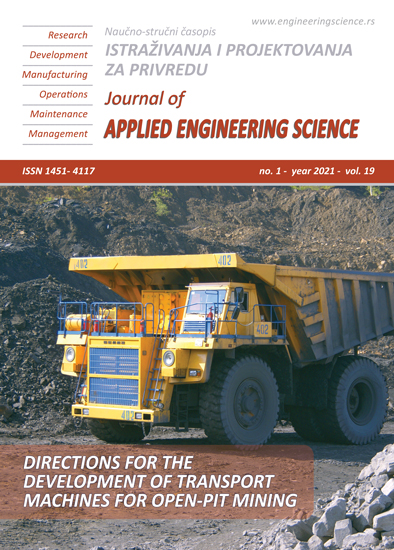FABRICATION OF EPOXY COMPOSITES REINFORCED WITH BAMBOO FIBERS
Abstract
This study aims to enhance the mechanical properties of polymer material using type of natural fiber. Bamboo fiber considered the strongest between the natural fibers group, it have low density, high mechanical strength in addition to its availability makes it economically viable and have potential for used as engineering material. The study is concerned with evaluate some of the mechanical properties (Tensile strength, Bending strength, Impact strength) for the resultant composite reinforced with 10, 20 and 30 vol.% of bamboo fibers, as compared with received material. With the natural reinforcement, the optimum mechanical properties in comparison with the as received epoxy were achieved. The results indicated that the tensile strength increased from 13.51 MPa to 33.50 MPa (that is a percentage increase of 150 %), also the bending strength increased from 24.25 MPa to 44.5 MPa (that is a percentage increase about 83 %), as well as, the increase of the impact strength from 41 kJ/m2 to 69 kJ/m2 (that is a percentage increase about 68 %).
References
Kannan, R., Ahmad, M. (2013). A review on mechanical properties of bamboo fiber reinforced polymer composite. Australian Journal of Basic and Applied Sciences, vol. 7, no. 8, pp. 247–253.
Athijayamani, A., Thiruchitrambalam, M., Manikandan, V., Pazhanivel, B. (2010). Mechanical properties of natural fibers reinforced polyester hybrid composite. International Journal Plastic Technology, vol. 14, no. 1, pp. 104–116.
Dweib, A., Hu, B., O’donnell, A., Shenton, W., Wool, P. (2004). All natural composite sandwich beams for structural applications. Composite Structures, vol. 63, no. 2, pp. 147–157, DOI:10.1016/S0263-8223(03)00143-0.
Monteiro, S., Lopes, F., Barbosa, A., Bevitori, A., Da Silva, I., Da Costa, L. (2011). Natural lignocellulosic fibers as engineering materials—an overview. Metallurgical and Materials Transactions A, Physical Metallurgy and Materials Science, vol. 42, no. 10, pp. 2963–2974, DOI:10.1007/s11661-011-0789-6.
Glória, G., Margema, F., Ribeiroa, C., de Moraesa, Y., da Cruzb, R., Silvac, F., Monteirob, S. (2015). Charpy impact tests of epoxy composites reinforced with giant bamboo fibers. Materials Research, vol. 18, pp. 178–184, DOI: org/10.1590/1516-1439.360614.
Okubo, K., Fujii, T., Yamamoto, Y. (2004). Development of bamboo-based polymer composites and their mechanical properties. Composites Part A, Applied Science and Manufacturing, vol. 35, no. 3, pp. 377–383, DOI: 10.1016/j.compositesa.2003.09.017.
Okubo, K., Fujii, T., Yamashita, N. (2005). Improvement of interfacial adhesion in bamboo polymer composite enhanced with micro-fibrillated cellulose. International Journal Series A Solid Mechanics and Material Engineering, vol. 48, no. 4, pp. 199–204, 2005, DOI: org/10.1016/j.compositesa.2003.09.017.
Costa, L., Monteiro, S., Loiola, R. (2010). Mechanical behavior of polyester composites reinforced with continuous bamboo fibers. Proceedings of the Characterization of Minerals, Metals & Materials-TMS Conference 2010, pp. 1–6.
Burgueno, R., Quagliata, M., Mohanty, A., Mehta, G., Drzal, L., Misra, M. (2005). Hybrid biofiber-based composites for structural cellular plates. Composite Part A: Applied Science and Manufacturing, vol. 36, no. 5, pp. 581–593, DOI: org/10.1016/j.compositesa.2004.08.004.
Tokoro, R., Vu, D., Okubo, K., Tanaka, T., Fujii, T., Fujiura, T. (2008). How to improve mechanical properties of polylactic acid with bamboo fibers. Journal of Material Science, vol. 43, no. 2, pp. 775–787, DOI: 10.1007/s10853-007-1994-y.
Samal, S., Mohanty, S., Nayak, S. (2009). Polypropylene—bamboo/glass fiber hybrid composites: fabrication and analysis of mechanical, morphological, thermal, and dynamic mechanical behavior. Journal of Reinforced Plastics and Composites, vol. 28, no. 22, pp. 2729–2747, DOI: org/10.1177/0731684408093451.
da Cruz, R., Junior, E., Monteiro, S., Louro, L. (2015). Giant bamboo fiber reinforced epoxy composite in multilayered ballistic armor. Materials Research, vol. 18, pp. 70–75, DOI: org/10.1590/1516-1439.347514.
Khan, Z., Yousif, B., Islam, M. (2017). Fracture behaviour of bamboo fiber reinforced epoxy composites. Composite Part B: Engineering, vol. 116, pp. 186–199, DOI:10.1016/j. compositesb.2017.02.015.
Martins, L., Margem, F., Monteiro, S., Loyola, R., Margem, J. (2014). Izod Impact Tests of Polyester Composites Reinforced with Bamboo Fibers of the Specimen Dendrocalmus Giganteus. Characterization of Minerals, Metals, and Materials 2014, pp. 581–587, DOI: 10.1002/9781118888056.ch54.
Fu, S., Lauke, B., Mäder, E., Hu, X., Yue, C. (1999). Fracture resistance of short-glass-fiber-reinforced and short-carbon-fiber-reinforced polypropylene under Charpy impact load and its dependence on processing. Journal of Materials Processing Technolgy, vol. 89, pp. 501–507, DOI: org/10.1016/S0924-0136(99)00065-5.

